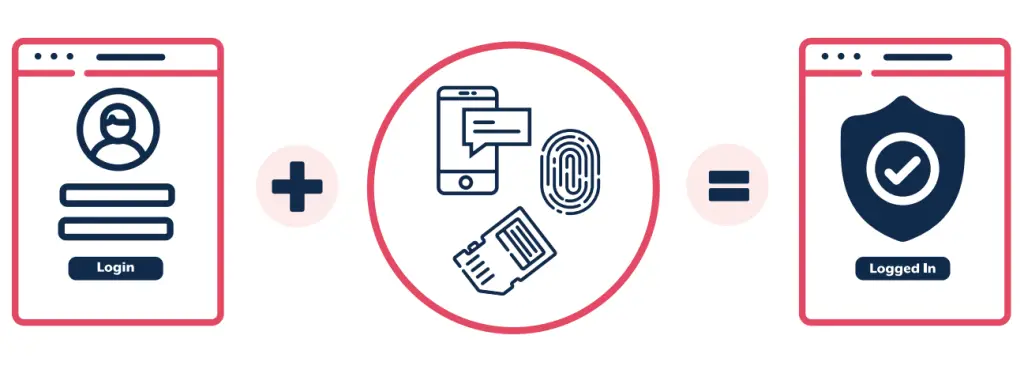Multi-factor authentication is an essential part of information security. It adds a security layer to sensitive data against potential breaches and malicious activities. And even if a user’s login credentials are mistakenly exposed, they will still enjoy some protection.
MFA reduces the risk the possibility of a breach and keeps data secure. In the past, we only needed a static username and password to access an account. But over time, that has appeared insufficient for security as hackers leverage weak or stolen passwords to carry out various attacks.
Using MFA to strengthen password security with another form of authentication has proven to keep away to a reasonable level. In fact, Microsoft has revealed that MFAs can prevent attacks on accounts up to 99.9 percent.
What is Multi-factor Authentication?

MFA is a method of authentication that requires two or more verification factors to be eligible to use applications, VPNs, online accounts, and other resources. At the fundamental level, authentication needs every online user to show who they claim to be by providing certain information—but MFA takes this further.
MFA requires the user to input more information to back up their proof. It is leveraging on the possibility that their password may have been leaked or their device stolen. And with two or more authentication factors, the chances of a hacker gaining unauthorized access to an account are considerably reduced.
Consequently, MFA stops most bad actors from taking action on your systems or making changes to your data. MFA is a crucial component of a strong identity and access management (IAM) policy.
Why is MFA Necessary?
The key effect of MFA on company resources is to enhance security. It does this by requesting users to identify themselves using more than a username and password. An attacker bent on the brute force approach may eventually gain access to sensitive resources. And even credentials can be stolen by third parties.
So, your resources are increasingly protected if they need to verify using a thumbprint or physical hardware key.
How Does MFA Work?
The concept behind Multi-factor authentication is simple: After inputting your username and password to verify your account, you need to use one or two verification methods to access resources finally. It could be in the form of a One Time Password (OTP) via SMS, email, or other methods. You can use OTPs to generate a unique code that will be used to log in to your account.
Also, habits can be challenging to break. And many organizations may not be able to eliminate usernames and passwords due to time or resources limitation. MFA keeps data and systems secure by adding roadblocks that hinder bad actors from gaining access to a network and causing harm to data.
So, even when your password or authentication method has been compromised, it is very rare that a hacker will also have a second or third authentication factor.
Here are Some Importance of Multi-Factor Authentication for Enterprise Security
1. MFA Strengthens Security Posture of an Organization
It provides an extra layer of security than 2FA. A company seeking more robust security can make it mandatory for their employers and consumers to verify their credibility through an extra layer of authentication which could be a password, Google Authenticator, or a Time-based One Time Password (TOTP). The MFA approach ensures that those accessing resources are people who they are.
Even if a hacker gets hold of a credential, they will still be forced to provide a pass for extra security, which could be a thumbprint. They are never likely to bypass that security; hence it bolsters the protection of resources.
2. It Secures Consumer Identity
Multi-factor authentication is very effective in protecting consumer data from identity theft. It supplements the security of the traditional username and password login through an extra layer of protection. The TOTP is neither sent through an automated phone call or SMS, making it a hard nut for cybercriminals to crack. Usually, a consumer will need two pieces of information to access their resources. MFA reinforces authentication with a sense of mindfulness.
3. It Can Be Easily Implemented
Multi-factor authentication can be easily implemented, and it doesn’t impact the rest of the virtual space of an enterprise or institution negatively. In addition, its intuitive user experience makes it easy for a consumer to pick it up with little to no effort.
4. MFA Is Compliant With Industry Security Regulations
Some of the requirements of Industry regulations such as HIPAA and PCI-DSS require MFA to be implemented along with Zero Trust model in the cloud in certain situations to avoid unauthorized users from gaining access to systems. However, it also applies to several other requirements, especially when complying with specific industry regulations. So even when application updates result in some unexpected consequences, they will remain virtually non-intrusive with MFA compliance.
5. MFA Complies With Single Sign-On (SSO) Solutions
With MFA compliant with industry regulations, it also comes with an SSO solution. You don’t have to create different passwords to access different applications. Using a secondary authentication with SSO confirms that the rightful person is being given access and evacuates risks of data theft as a result of password misplacement. Aside from enhancing the security of resources, this also saves time.
6. MFA is A Next-Level Security Feature
Even for organizations operating remote systems, MFA is next-level security, mainly when used with an SSO solution. Cybercriminals try to take advantage of remote work systems to attack a network. Still, MFA can help block such access and even notify the IT department of malicious activities on the network. This will help the experts take decisive actions to block such users.
There have been many concerns due to increased phishing attacks, pharming, and keylogging for organizations in diverse industries globally, especially on an open network. MFA settles all the issues by, for instance, through a prompt to confirm secondary authentication even in the face of a leaked password.
7. MFA Can Evenly Adapt To The Change In a Workplace
As workplace systems are affected by a wide range of factors and employees are forced to work outside the office systems, organizations request to bolster their security with more complex access requests. When multi-factor authentication offers different security layers, adaptive multi-factor authentication eliminates the risk presented by a user when they need to access software or information, especially by putting the user’s device and location in context.
Adaptive MFA also permits potential change in policies and step-up authentication, which are critical controls in protecting data. For instance, users may require enhanced assurance second factor — or the third factor — before they are given access to highly sensitive data, including customer data.


